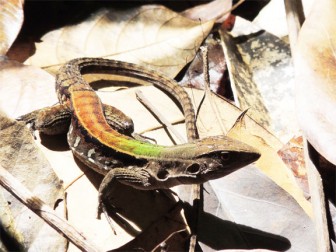When most people think of the rainforest, they picture large spotted cats like the jaguar, massive snakes like the anaconda, huge spiders like the goliath bird-eater and toothy predators like the black caiman. And while Guyana certainly has a reputation for hosting healthy populations of these large-bodied species as the ‘Land of Giants,’ today’s instalment of In the Rainforest is going to focus on a species that is much smaller in stature.
The Striped Forest Whiptail lizard (Kentropyx calcarata) is commonly encountered in the Kanuku Mountains of Region 9. Whether basking in a sunny spot on the forest floor near Mapari Creek (Katoka village) or scurrying to catch insects that get caught in the moist updrafts around Jordan Falls (Nappi village), this lizard is a staple of the forest floor. Low to the ground with stout legs, a compressed body and a flat, blunt head; this species was built for life on the forest floor. It uses its short legs, long toes and sharp claws to produce short, very quick bursts in pursuit of insect prey. Its head serves almost like a shovel, allowing this lizard to dive to safety beneath the leaf litter. Its mostly brown flanks with black striped, checkered or diamond shaped pattern allows it to blend in brilliantly with the leaves and woody debris.
But the brilliant red and green colouration that shows on the back of this lizard is clearly what sets it apart. Generally, colour change in lizards is thought to match one of two purposes. The first is to help with the absorption of heat. Have you even worn a black shirt on a hot sunny day? If you have, you know that dark colours are better at absorbing the sun’s heat than lighter colours. As an ectotherm (or cold-blooded animal), this lizard is dependent on the warm rays of the sun to maintain its internal body temperature. So for lizards, sun bathing is literally about survival. By changing colour, this lizard (and almost all reptiles really) can help their own cause by allowing for more efficient absorption of warmth from the sun, which is often necessary after a long cool night.
The second main reason why lizards change colour is to show aggression. The lizard world is one that is highly competitive, especially if you are a male. Lizards establish territories for mating often through direct competition or fighting. So once a lizard has established a territory that may host several eligible females, he will do anything to keep it. But constantly fighting with other lizards comes at a cost. The risk of injury is high, which ultimately lowers the probability that you can mate and pass on your genes to the next generation. So as an alternative to fighting, male lizards stay vigilant and do their best to look intimidating. Bright colours indicate danger in the animal kingdom and putting on a show of brilliant colour like this may help this species avoid a direct fight which could result in injury or worse.

(Photo by M Hallett)
The intriguing thing about this beautiful lizard is that much of the information above is based on direct observation. Even a simple ‘Google’ search of this species will result in very little information about the Striped Forest Whiptail lizard. This species serves as yet another example of how we need the next generation of explorers and scientists to keep learning about our environment so that we can make informed decisions that help us preserve it for the future.
Rain forests are rich in biodiversity and are home to many different plants and animals as well as indigenous communities.
Humans, even those who don’t live in the rain forest, rely on it for resources such as building materials (wood and lianas), medicine and fruits.
Rain forests also provide essential environmental services for life on earth; they create soil as well as prevent soil erosion, produce oxygen through photosynthesis, maintain clean water systems, and are a key defence against climate change.
The Iwokrama Rain Forest is 371,000 hectares, located in the heart of Guyana. Our mission is to develop strategies for conservation and sustainable development for local people in Guyana and the world at large.
We are involved in timber, tourism and training. Come and visit us in the rain forest or at http://www .iwokrama.org.





